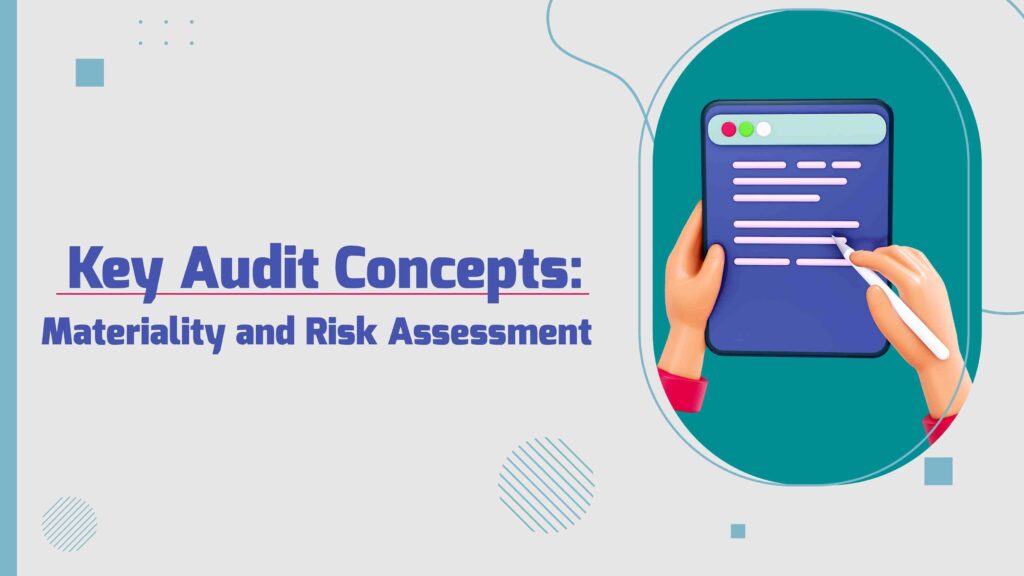Here, we’ll break down the complexities of financial checkups, commonly known as audits. Get ready to embark on a journey of financial discovery, demystifying the audit process step by step.
1. The Basics of Audits: What, Why, and How?
Let’s start with the basics. What exactly is an audit, and why is it essential for businesses? We’ll unravel the purpose behind audits, exploring why they exist and how they help ensure financial transparency and accuracy.
What Are Audits Anyway?
Picture audits as the Sherlock Holmes of the financial world. They’re the meticulous process of examining and verifying an organization’s financial records, transactions, and statements. It’s like a magnifying glass over your numbers, ensuring they’re accurate, transparent, and free from errors.
Why Do Audits Exist?
Think of audits as the guardians of financial integrity. They’re here to make sure everything’s in order and that financial information can be trusted. Audits help prevent fraud, mismanagement, and inaccuracies, which is like having a superhero that swoops in to save the day.
The Auditing Dance: How It Works?
Imagine an audit as a carefully choreographed dance between auditors and the business being audited. Auditors follow a structured process, gathering evidence, testing controls, and digging into financial nooks and crannies. It’s like they’re waltzing through your financial data, ensuring every step is in harmony.
2. Types of Audits: A Brief Overview
Audits come in different flavours. We’ll delve into the various types of audits, from external to internal, and even touch on tax audits. Each type serves a unique purpose, contributing to the overall financial health of an organization.
External Audits: The Celebrity Spotlight
Imagine external audits as the red carpet event of the financial world. They’re like the A-listers of audits, performed by independent experts to ensure the accuracy of financial statements. These audits bring the glitz and glamour, providing stakeholders and investors with a trustworthy glimpse into a company’s financial health.
Internal Audits: The Company’s Best Friend
Think of internal audits as the loyal sidekick, always there to lend a helping hand. These audits are conducted within the organization, focusing on evaluating internal controls, processes, and risk management. It’s like having your own financial detective squad, keeping an eye on operations and suggesting improvements.
Tax Audits: The Numbers Game
Tax audits are like a numbers-based treasure hunt, ensuring that businesses play by the tax rulebook. Tax authorities carefully examine financial records to verify accurate reporting and compliance with tax laws. It’s like a financial safari, hunting down any discrepancies in your tax kingdom.
Performance Audits: The Efficiency Experts
Picture performance audits as the efficiency gurus. They dig into the nitty-gritty of operations to ensure resources are used wisely and goals are achieved. These audits are like personal trainers for your business, helping it stay in tip-top shape and perform at its best.
Forensic Audits: The Financial Detectives
Ever dreamed of being a financial detective? Forensic audits turn that dream into reality. They’re like crime scene investigations for finance, uncovering fraud, misappropriation, and financial misconduct. Think of forensic auditors as the Sherlock Holmes of the financial world, piecing together clues to solve complex financial mysteries.
Environmental Audits: Eco-Friendly Insights
Audits aren’t just about numbers; they can be eco-friendly too. Environmental audits focus on a company’s environmental impact, ensuring compliance with regulations and promoting sustainable practices. It’s like a green thumbs-up for businesses that strive to protect the planet.
3. The Audit Process: From Kick-off to Conclusion
Ever wondered what happens during an audit? We’ll guide you through the entire process, from the initial planning and data collection to the meticulous examination of financial records. You’ll gain a clear understanding of the audit timeline and the steps involved.
Setting Sail: The Kick-off Phase
Imagine the kick-off phase as the launch of a grand expedition. It’s like the moment you step onto the ship, ready to explore uncharted territories. During this phase, auditors and auditees (that’s you!) meet to discuss objectives, scope, and expectations. It’s like laying out the treasure map before the real quest begins.
Gathering the Crew: Data Collection
Think of data collection as assembling your crew of experts. Auditors gather evidence, scrutinize financial statements, and delve into transactions. It’s like gathering pieces of a puzzle, each one contributing to the bigger picture. During this phase, you provide documents, records, and financial insights – your ship’s logs for the auditors to study.
Sailing the Audit Seas: Examination and Analysis
Now comes the exciting part – the examination and analysis phase. Auditors meticulously review your financial data, like expert sailors navigating through stormy waters. They test controls, verify transactions, and ensure the ship of your financial records is seaworthy. It’s like checking every nook and cranny to ensure smooth sailing.
Plotting the Course: Evaluating Internal Controls
Just as skilled sailors chart their course, auditors evaluate your internal controls. It’s like inspecting your ship’s equipment to make sure everything’s shipshape. They assess the systems in place to manage risks, prevent errors, and maintain financial accuracy.
The Final Destination: Reporting and Conclusion
Congratulations, adventurers – you’ve reached the final destination! Auditors compile their findings into a comprehensive report. It’s like presenting a well-organized treasure chest of insights, complete with observations, recommendations, and conclusions. This report helps you understand the financial voyage and highlights areas for improvement.
4. Players in the Audit Game: Roles and Responsibilities
Meet the cast of characters that make an audit happen. From auditors to auditees, everyone plays a role. We’ll highlight the responsibilities of each player, ensuring you know who’s who in this financial theater.
The Auditors: Your Financial Detectives
Meet the auditors, your financial detectives. They’re the ones donning the magnifying glasses, scouring your financial records, and uncovering hidden gems. Just like Sherlock Holmes, auditors are meticulous in their investigations, ensuring accuracy, transparency, and compliance with financial regulations.
Auditees: The Stars of the Show
Now, let’s welcome the auditees – that’s you! You’re the stars of the audit show, opening your financial doors and providing access to the treasure trove of records. Your role? To collaborate with auditors, share insights, and ensure a smooth audit process. Think of auditees as the gracious hosts of this financial party.
Management: The Puppeteers of Control
Behind the scenes, management pulls the strings like expert puppeteers. They set the tone, establish internal controls, and ensure the ship of financial operations stays on course. It’s like crafting a well-scripted play, where management’s decisions shape the narrative of the audit performance.
The Audit Committee: Guardians of Oversight
Enter the audit committee, the vigilant guardians of oversight. They’re like the directors of the financial play, ensuring auditors follow their script and perform their roles with integrity. The audit committee’s responsibility is to oversee the audit process, maintain independence, and safeguard transparency.
The Supporting Cast: External Experts
While auditors take center stage, they often bring along a supporting cast of external experts. These specialists provide additional insights and expertise in specific areas, ensuring a comprehensive and well-rounded performance.
5. Key Audit Concepts: Materiality and Risk Assessment

Audit lingo can be puzzling, but fear not! We’ll explain crucial concepts like materiality – the significance of errors – and risk assessment – identifying potential pitfalls. These concepts drive the audit’s focus and depth.
Materiality: The Significance Scale
Imagine materiality as the spotlight on a Broadway stage – it highlights what really matters. In the financial world, materiality helps auditors determine the significance of errors, omissions, or discrepancies. It’s like gauging whether a missing puzzle piece changes the overall picture. Materiality ensures auditors focus on what truly impacts the financial narrative.
Unraveling Risk Assessment: The Adventure Begins
Think of risk assessment as the starting point of your financial adventure. Just like a treasure map, it helps auditors identify potential pitfalls and challenges. They assess the risks of misstatements, fraud, and other financial hiccups that could alter the course of the financial story.
The Risky Business of Risk Assessment
Risk assessment is like playing financial chess – auditors anticipate moves to safeguard the king (your financial accuracy). They evaluate internal controls, examine processes, and calculate the likelihood of errors. It’s like predicting which chess piece might make a wrong move and jeopardize your financial strategy.
Minimizing Risk: The Auditor’s Safety Net
Think of risk assessment as a safety net – auditors set it up to catch any potential financial falls. They identify weak spots, assess the likelihood of errors, and ensure your financial ship sails smoothly without hitting unexpected storms.
6. Gathering the Puzzle Pieces: Audit Evidence
Think of audits as piecing together a jigsaw puzzle. We’ll uncover the importance of audit evidence, from financial statements to supporting documents. Learn how auditors use this evidence to form a clear picture of your financial landscape.
Types of Audit Evidence: Clues Everywhere!
Think of audit evidence as the breadcrumbs leading to financial truth. Auditors collect a variety of evidence, including records, papers, testimonials, and observations. It’s similar to gathering hints from fingerprints, security footage, and witnesses in order to unravel an engrossing mystery.
Documents Galore: The Written Testimonies
Picture documents as the written testimonies of your financial journey. Auditors examine contracts, invoices, receipts, and other paper trails. It’s like flipping through your financial diary, where every page tells a story of transactions and agreements.
Digital Footprints: The Virtual Clues
In today’s digital age, auditors follow virtual footprints. They analyze electronic records, emails, and digital transactions. It’s like tracking online breadcrumbs to uncover the path of financial activities, ensuring nothing goes unnoticed.
7. Beyond the Numbers: Understanding Audit Reports
Once the audit is complete, it’s report time. We’ll demystify audit reports, explaining what they contain and how to interpret them. Discover how audit findings are presented and what actions they may trigger.
The Audit Report Unveiled: Your Financial Storybook
Imagine audit reports as your financial storybooks. They’re not just dry documents; they’re narratives that auditors craft to reveal the journey of your financials. These reports summarize audit findings, highlight key observations, and provide an overview of your financial landscape.
The Language of Audit Reports: Cracking the Code
Think of audit reports as secret codes auditors decode for you. They use specific language, terms, and formats to convey their findings. It’s like understanding a foreign language – auditors help translate the financial story into words you can comprehend.
Sections of an Audit Report: Chapters of Your Story
An audit report is like a multi-chapter book, with each section revealing a different aspect of your financial narrative. From the introduction to the management’s responsibility, auditors’ opinion, and findings – each section has a role in painting the complete picture.
The Heart of the Matter: Auditor’s Opinion
The auditor’s opinion is the climax of the financial story – the moment of truth. It’s like the verdict in a courtroom drama, where auditors render their judgment on the fairness and accuracy of your financial statements.
Your Action Plan: Using Audit Reports Wisely
Now that you have your financial storybook, it’s time for action. Use the insights and recommendations to fine-tune your financial strategy, strengthen controls, and address any weaknesses. Think of audit reports as a roadmap to improving your financial performance and ensuring a happy ending.
8. Audits for Small Businesses: Tailoring the Process
Audits aren’t just for the big players; small businesses benefit too. We’ll discuss how smaller enterprises can navigate audits, offering tips to streamline the process and ensure compliance without unnecessary stress.
The Perfect Fit: Why Small Businesses Need Tailored Audits
Think of audits as fashion designers – they create unique pieces that fit perfectly. Small businesses have unique requirements and difficulties, therefore a one-size-fits-all strategy is insufficient. Custom audits make that the procedure is effective, pertinent, and in line with your company’s objectives.
The Audit Tailoring Process: Customizing Your Experience
Think of an audit as a custom suit made just for you. In order to comprehend the operations, dangers, and goals of small enterprises, auditors collaborate closely with them. Measurements are taken to make sure the suit fits perfectly, much like in a tailor’s appointment.
Focus on Essentials: Streamlining the Scope
Just as a tailored suit highlights your best features, a tailored audit focuses on what matters most. Auditors pinpoint key areas, prioritize risks, and streamline the audit scope. It’s like choosing the right fabric and design elements for your unique suit.
Navigating Challenges: Addressing Small Business Concerns
Small businesses face distinct challenges, and tailored audits address them head-on. Auditors adapt procedures, consider resource limitations, and offer practical solutions. It’s like adding extra pockets to your suit to accommodate your specific needs.
Building a Partnership: Auditors as Trusted Advisors
Think of auditors as your fashion consultants, guiding you through the process with expertise and care. They serve as reliable professionals, offer insights, and exchange best practices. Having a personal stylist who makes sure you always look your best is similar to that.
The Benefits of Tailored Audits: Confidence and Insights
Tailored audits offer more than a perfect fit – they provide confidence and insights. You may be sure that the audit procedure is customized to meet your objectives and that the findings provide insightful information for development and enhancement. It’s similar to confidently walking down the runway while highlighting the special qualities of your company.

9. Audit Compliance: Tips and Best Practices
Preparation is key to a successful audit. We’ll provide practical advice on how to get your financial house in order, organize records, and create a smoother audit experience for everyone involved.
Navigating the Compliance Waters: Setting the Course
Imagine compliance as your navigational map – it guides you through the audit journey. Start by understanding the audit requirements specific to your industry and jurisdiction. It’s like plotting your course on the map before embarking on a thrilling expedition.
Document Diligence: Keeping a Reliable Log
Think of documents as your ship’s logbook. Maintain organized and updated records of financial transactions, agreements, and processes. It’s like having a detailed journal of your journey, ensuring you can retrace your steps with ease.
All Hands on Deck: Collaborating with Your Team
Audit compliance is a team effort, like sailing with a skilled crew. Involve relevant team members, communicate clearly, and assign responsibilities. It’s like each crew member having a specific role to ensure the ship runs smoothly.
Airtight Internal Controls: Securing Your Ship
Just as a ship needs strong hulls, your business needs robust internal controls. Implement measures to prevent errors, fraud, and ensure accuracy. It’s like having watertight compartments to keep your ship afloat even in rough waters.
Regular Check-ins: Smooth Sailing Ahead
Regularly review your financial processes and controls, like checking the ship’s equipment before departure. This ensures everything is in order and ready for a seamless audit experience.
Honing Communication: Clearing the Fog
Communication is key – keep auditors in the loop about changes, challenges, and improvements. It’s like signaling to other ships to avoid collisions, ensuring a safe and smooth audit voyage.
The Mock Voyage: Preparing for Audit Landfall
Conduct mock audits to prepare for the real deal. It’s like simulating a voyage to identify potential hurdles and fine-tune your compliance strategy.
The Final Port: Post-Audit Reflection
After the audit, reflect on the experience. What went well? What could be improved? It’s like reviewing your voyage and making notes for the next adventure.
10. Embracing Audits as Opportunities: Learning and Improvement
Audits aren’t solely about scrutiny – they’re learning opportunities. We’ll explore how organizations can use audit insights to drive improvements, enhance financial practices, and ultimately thrive in a dynamic business environment.
Audits: Your Business’s Annual Check-Up
Analyze audits as the yearly physical of your firm. Audits ensure that your finances are in good condition, much like you visit a doctor to check on your health. They highlight both strengths and weaknesses as well as areas that require improvement.
Uncovering Hidden Gems: Insights for Success
Audits are like treasure hunts – they unearth hidden gems of information. Auditors provide insights into your financial landscape, helping you discover opportunities to enhance efficiency, cut costs, and boost profits.
A Fresh Perspective: The Audit Advantage
Auditors bring an outsider’s perspective, like a fresh set of eyes on a puzzle. They spot patterns, anomalies, and potential strategies you might have missed, adding value to your financial game plan.
Learning from Mistakes: The Growth Mindset
Mistakes uncovered during audits are like stepping stones to growth. Embrace them as valuable lessons that contribute to your business’s evolution. It’s like turning stumbling blocks into building blocks.
Streamlining Processes: The Efficiency Boost
Audits highlight areas where processes can be streamlined. It’s like fine-tuning a machine to operate at maximum efficiency, saving time, effort, and resources.
Tailoring Strategies: Customized for Success
Use audit insights to tailor strategies that align with your business’s unique needs. It’s like designing a tailor-made suit – it fits perfectly and boosts your confidence.
Reinforcing Trust: Building Credibility
A successful audit reinforces trust with stakeholders. It’s like adding another layer of trust to your business’s foundation, enhancing your reputation and credibility.
A Roadmap for Improvement: The Audit Report
Audit reports provide a roadmap for your improvement journey. It’s like having a detailed itinerary for an exciting adventure, guiding you toward financial success.
Well done, you’ve finished “Audit 101”! Now that you have this understanding, you may approach audits with confidence and demystify them. Watch this space for additional financial insights as we continue to learn about auditing!
Visit Our Website for More!


